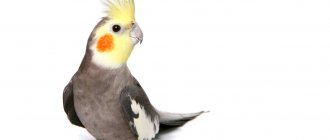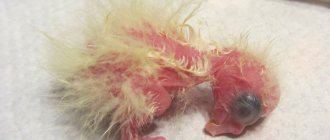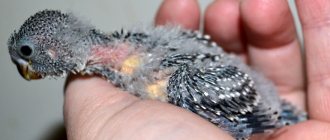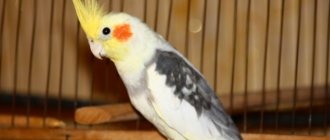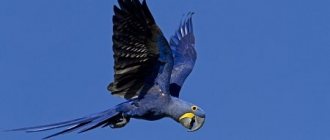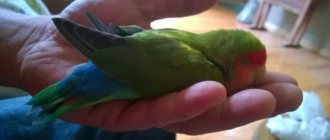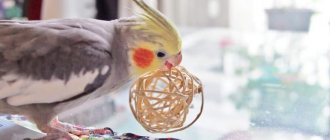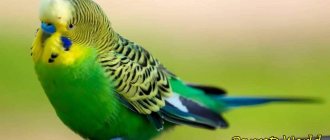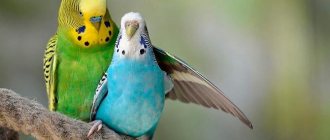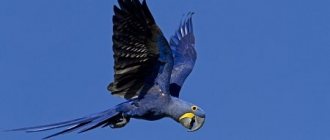When deciding to get such an interesting pet as a parrot, it is important to familiarize yourself in advance with the behavior and routine of these birds. Creating comfortable conditions that are close to natural will have a positive effect on the pet’s health and increase its lifespan. One such important point that should be given special attention is the parrot's sleep. To equip everything you need at home, it is important to know how parrots sleep in natural conditions.
Features of sleep in natural conditions
The period of active wakefulness of a parrot includes the entire daylight hours - on average it is about 12-14 hours. As soon as night falls, the birds fall asleep. During the day, parrots also sleep a significant amount of time. The fact is that in nature these exotic birds live in conditions of high humidity and air temperature. Therefore, in the middle of the day, when the heat reaches its greatest levels, they hide in deep shade to take a nap. It turns out that parrots sleep at least 10 hours at night and several hours extra during the day. Maintaining just such a routine guarantees the proper development and health of the bird.
Education
One of the hallmarks of cockatiels is their tendency to learn. Young individuals aged 12–14 weeks are especially successful in training. Their older relatives are more likely to show caution, which somewhat slows down the process of mastering skills, but does not make it ineffective. Such birds need a patient attitude and time.
Ornithologists advise choosing one family member to practice with a cockatiel. Training should be short but daily. The more a bird gets used to communicating with people, the easier it is to train it. It is believed that before starting training, it is necessary to carry out such a painless procedure for the bird as trimming the wings. The cockatiel can be toilet trained, perform the commands “can”, “can’t”, “forward”, “back” and some other simple actions, as well as imitate the sounds of human speech, that is, talk.
Parrots are beautiful and intelligent creatures. Caring for cockatiels is not difficult. It is not surprising that many bird lovers prefer them. Even novice poultry keepers can easily care for a cockatiel.
Sleep patterns when living at home
Being in captivity, a pet often cannot navigate the daylight hours; the peculiarities of the Russian climate are also very different from the native conditions of the bird. Therefore, the owner’s task is to create artificial conditions close to the natural regime. Understanding how much parrots usually sleep in the wild will help normalize your pet's routine.
A significant part of a parrot's sleep occurs at night, and usually owners go to bed later and get up earlier than their pets. Therefore, it is recommended to cover the cage with a thick fabric cape at night - this way you can turn on the light without disturbing the bird. It is better not to use heavy synthetic fabrics - it is important to ensure sufficient air flow so that the pet does not suffocate.
You need to calculate the number of hours of sleep according to the time of year. In summer, parrots are more active and energetic, they need less time to regain strength - sleep can be about 10 hours a day. In winter, the metabolism slows down, the bird needs longer rest, about 14 hours. During daytime sleep, it is also better to cover the cage so that the pet is not disturbed.
Suitable diet
It is believed that the bulk of a parrot's diet comes from seeds. However, ornithologists specify that their quantity should be approximately a third of the amount of food eaten per day, since the seeds contain a lot of fat.
Special balanced food containing useful substances has been developed for cockatiels. In addition, birds happily eat natural foods such as vegetables, fruits, eggs, and beans. They can be given in small portions. Sprouted seeds can also be used as an addition to the main diet.
How should a parrot sleep?
Owners often worry about the health of their new pets. If a parrot is lethargic and sleepy most of the day, sitting with a ruffled face, the reasons can be very different. In the first days in a new place, the bird experiences severe stress, so a large amount of sleep is normal. This will help your pet recover from the shock. But if there are no visible improvements within three to five days, you should pay closer attention to the health of the parrot.
If a bird sleeps with its feathers ruffled and hides its head under its wing, it is trying to raise its body temperature. Signs that your pet is freezing cannot be ignored. Unsuitable temperature conditions can lead to a serious cold, so it is better to immediately move the bird to a warmer room and install a heater or lamp.
Sometimes parrots can sleep with their eyes open - this is not a sign of illness. Under natural conditions, lowering the eyelids helps birds protect themselves from bright light during the afternoon siesta. But at night the light does not interfere and they often leave their eyelids raised, this also helps to notice the approach of a predator in time. Therefore, if a pet sleeps with its eyes open, this only means that the room is in comfortable twilight.
What to do if your parrot sleeps for days on end. Many pet breeders are asking this question, concerned about such unusual behavior of their pets. And indeed, any deviation from the normal behavior of birds immediately attracts attention and makes you worry about your parrot.
In the following article we will try to look in detail at the reasons why your parrot is constantly sleeping and whether this is a cause for concern.
Bird care
One of the main responsibilities of a cockatiel owner is caring for the bird. It is as follows:
- feeding your pet healthy food;
- ensuring constant access to clean water;
- communication with birds;
- observing the psychological state of the bird, normally it should not bite or show other signs of aggressive behavior;
- maintaining the health of the parrot, identifying symptoms of diseases, and regular visits to the veterinarian.
The time a parrot needs to replenish its strength
Parrots are living creatures just like people. That’s why from time to time they need to take a good nap to take a break from the hustle and bustle of the day and replenish their strength. Moreover, your pet can rest not only at night, but also during the day.
At such moments, you probably saw a bird sit on a perch and doze off, ruffled. But as soon as you make the slightest noise, she immediately comes to her senses.
Sometimes you may even think that your parrot sleeps a lot. In fact, the birds themselves know very well how much time they need to rest.
The average budgie spends up to ten hours a day getting a good night's sleep. Moreover, he rests not only at night, but also during the day. In cases where, for some reason, your pet is not able to rest properly, he will probably look depressed and tired.
That is why novice breeders are advised to take a responsible approach to keeping their birds and cover their cage with thick material at night. Thus, the parrot will not see any extraneous light sources that could disturb him.
How to create comfortable conditions for a feathered pet to rest?
I have already talked about how the sleep of little parrots is organized. Now let's talk about the big ones. For example, a cockatiel is quite large and strong, how can you please it? There is nothing to be afraid of.
Creating comfortable conditions for the parrot to rest
With proper care and sufficiently large space for living, this pet seems unpretentious. Breeds like this require space and freedom. It is better to give the bird the entire room at its disposal, but first remove dangerous objects from there.
In a cramped cage one cannot avoid depressed mood, apathy, and subsequently even muscle dystrophy. Corella does not want such a fate, and therefore may rebel and show aggression.
You need to be given the opportunity to hide or retreat somewhere, and if there is nowhere to hide from the apparent danger, the strong-billed flyer will certainly attack. This is his only defense in this situation.
Consequences of lack of sleep in parrots
And the more he worries about his safety, the less soundly he sleeps. And chronic lack of sleep threatens many health problems.
For example:
- shedding feathers in incredible quantities;
- furious self-plucking;
- lethargy, drowsiness;
- nervous behavior;
- aggression;
- depression;
- acquiring offspring contrary to the plans of the owner.
Features of bird rest
Many novice breeders of small parrots are often surprised at how their feathered charges sleep. In this case, we mean the poses in which budgies prefer to rest during the day and at night.
One such feature is the position when your pet stands and at the same time dozes on one leg. This feature probably puzzled you, because sleeping and maintaining balance at the same time is probably not an easy task.
However, this rule does not work in the case of feathered pets. If your parrot sleeps on one leg all the time, it means it is more comfortable for him and there is no deviation in this case.
Many birds like to doze while standing on one leg. The exception is, as a rule, young individuals. They are not yet strong enough and cannot sleep and maintain balance at the same time. Therefore, during their growing up period, they rest standing on both legs.
However, if your parrot is old and does not have good strength and coordination, he may begin to fall while sleeping. Surely you have heard that more experienced breeders, who have had more than one generation of birds, often have cases when they wake up in the middle of the night from noise. Moreover, its source was none other than an elderly parrot, who lost his balance while sleeping and fell from his perch.
In such cases, the birds begin to panic and rush from side to side, simultaneously waking up everyone who is nearby. If you become an involuntary witness to this phenomenon, then you need to immediately turn on the light in the room and let the parrot calm down. It will be great if you give your panicking pet some of your time and talk. This approach is optimal in order to calm your patient down as quickly as possible and allow him to fall asleep again.
Another interesting feature related to how your pet naps is the position of its head. Surely you have noticed that he often turns his head and hides it under his wing behind his back. However, this behavior can be explained quite simply.
According to generally accepted opinion, parrots insulate themselves in this way and create a kind of barrier from possible drafts. Therefore, it is very important to pay attention to your charges and as soon as they go to bed, immediately close the windows in the apartment. Thus, you will not only eliminate the causes of possible drafts, but also maintain the health of your pet.
Night sleep disorders
It's a bad sign if the parrot doesn't sleep after dark. He probably complains, making loud and incomprehensible sounds. He doesn’t sit still, he rushes about. First of all, you need to carefully examine the bird for any injuries.
She could fall from the perch in her sleep, losing her balance, and hurt herself. If a wound is found, it is treated in the same way as a child’s – with hydrogen peroxide, for example. But there may be a turning point. In the morning, it is advisable to show your pet to a doctor.
Most often, sleep is disturbed by fear. What alarmed the bird? Yes, anything, even a shadow running along the wall from the headlights of a passing car. It is necessary to create conditions for rest - silence, darkness, and a miracle will happen - the troublemaker will fall asleep.
How parrots sleep. Shurik is sleeping.
There may be other reasons for his concern. Diseases of internal organs. Parasites, finally. An ornithologist will definitely find out the truth if you contact him.
Keeping at home
The bird is unpretentious, but there are certain subtleties in its maintenance that you must be aware of at the stage of planning your purchase. First you need to learn how to feed and care for the nymph, and only then go after the chick. The health and life of your pet depends on the quality of care. Good care and maintenance allow cockatiels to live at home for more than 10 years, to be vigorous, beautiful, and active.
Feeding
By nature, the nymph parrot is granivorous. The ideal food for him would be a mixture of cereals. The nymph will not refuse fruit either. He enjoys eating pieces of apples, oranges and bananas. In spring, it is useful to provide twig food, from which the bird will peck buds and bark.
Poor quality food leads to gastrointestinal disorders, so food should always be fresh. Feed is given twice a day so that it is eaten within 10-15 minutes. It is allowed to add grain in the evening, before closing the cage, then the parrot will be able to have breakfast early. After feeding, all residues are removed, the feeder is rinsed and wiped dry.
- canary grass seeds,
- millet,
- oats,
- hemp.
You can include some rapeseed and rapeseed seeds in the mixture. Birds eat dried wheat reluctantly. It needs to be soaked or germinated. Hemp seed can be given no more than a dozen grains per day, otherwise the bird may go blind.
Occasionally poppy seeds . They prevent digestive disorders. Poppy seeds can be added to carrot pulp or given separately.
An adult pet eats 2 tablespoons of grains per day.
There should always be clean water in the cage. Drinkers are washed once a day. Occasionally, you can give mineral water instead of regular water.
Mineral supplements required:
- sepia,
- crushed boiled shells,
- sand.
Once a week, add 2 drops of fish oil to the grain. Twice a month give 1-2 tablespoons of sprouted grain. The size of the sprouts should be no more than 1 mm. Give a multivitamin preparation twice a week in the amount indicated on the package.
Care can be daily or weekly. It is enough to do something once a month or a year.
Daily:
- wash the drinking bowl and feeder;
- change water and food;
- clean the bottom, bath and sandbox;
- wash and wipe dry perches and perches;
- scald with hot water, dry and hang the toys again.
Once a month:
- change branches;
- carry out disinfection with a bleach solution.
Change once a year:
The pet must be allowed into the room. Without this, he will not be able to maintain good shape. Each nymph parrot must fly about 1 km daily - its life expectancy depends on this.
In the warm season, the cage is taken out into the fresh air so that the pet receives ultraviolet light. At the same time, there must be shaded areas in the house where the nymph can hide from overheating.
In winter, daylight hours are extended by turning on fluorescent light bulbs for 4-5 hours. The optimal temperature for keeping is +18…20 C. Birds tolerate cold better than overheating.
Attention
You need to communicate with your pet daily. In nature, birds live in numerous flocks. Communication is vital for them.
The bird is given a lot of time from the first days of its appearance in the house. It will not be difficult to communicate with her - parrots love to play and learn new things. In nature, they constantly maintain contact between all members of the pack and exchange various signals.
By taking a young chick into your home, you can accustom it to yourself in just two weeks. The first days together will be a great time to establish an atmosphere of trust and friendship for the rest of your life. A tamed pet becomes a member of the family, easily learns to talk and perform simple tricks.
Hand training begins when the nymphal parakeet fearlessly takes food from the feeder. You need to stick your palm with grains into the cage and wait until the bird starts pecking at them.
Then it’s time for walks. Holding the bird in your hand, it is easy to take it out of the cage, and after a while, lure it back into your palm and return it to the house. Such exercises are repeated daily during feeding. Typically, walks begin no earlier than one to two months after purchase.
Getting to know the cockatiel
Due to the characteristic crest and strong beaks of Australian parrots, the nymph corella is classified as a member of the cockatoo family, but is classified as a separate subspecies. In Europe, nymphs appeared in the 30s of the 19th century, and the first cockatiels began to be imported to Russia only in the middle of the 20th century. And now these birds are becoming increasingly popular among bird lovers.
Corellas in their natural habitat like to spend a lot of time on the dry trunks of dead trees, and against such a background, thanks to the colors of their plumage, they are perfectly camouflaged from enemies. The natural color of parrots is dark olive-gray, with a brownish tint. The front of the head, crest and cheeks are different shades of yellow. A charming “blush” stands out on the cheeks - specks of orange-red or pale brown.
Males are quite bright, females have duller plumage.
Nymph parrots are medium-sized birds, reaching 30-33 cm in length, 14-16 cm on the tail, and weighing 100 grams.
The ease of breeding cockatiels at home has led to the emergence of color varieties ranging from pure white to yellow birds with red eyes.
According to reviews from owners, these birds have a high level of intellectual development, are well trained in human speech and reproduce it in a very original way. Caring for cockatiels is not difficult, the main thing is to provide them with optimal living conditions. What will allow the bird to live with you long enough: the average life expectancy of cockatiels in captivity is 16-18 years.
How to teach a parrot to talk?
The nymph's onomatopoeia consists of sounds reminiscent of chirping. Words can be pronounced more or less legibly, the vocabulary is individual. A chick up to one year old can be taught to speak. Males are considered more talented students.
How to teach talking:
- In the morning or evening, curtain the cage with a cloth that does not allow sunlight to pass through so that the bird calms down and prepares for the lesson;
- repeat a certain phrase or word many times;
- preference should be given to words with hissing letters;
- reward occasionally with treats.
Learning the first phrases, if the bird is less than a year old, takes only 4-5 weeks. The main thing is to learn to speak every day. The bird being trained must be absolutely tame. It’s good if during a lesson the pet blinks slowly and closes its eyelids - this indicates that it is listening attentively to its owner.
Subtleties and nuances of care
The most important thing that the owner of a bird should never forget is its Australian origin, therefore care, care and warmth are the main components of its daily life, which the owner must provide.
The most optimal temperature for keeping a Corella parrot is approximately 20 degrees. If this figure is a little higher, that will also be good. And vice versa, if this temperature is lower, then it should be raised artificially, using a heater or a special lamp. But in such a situation, it is also necessary to take into account the air humidity in the room, on which the health and general good condition of the bird directly depends.
We recommend reading: Are Ticks on Dogs Dangerous to Humans?
A sufficient amount of fresh air is another serious issue on which the health of the parrot depends. But here you should be careful that, along with fresh air, there are no dangerous drafts in the room that could seriously harm your pet.
Care immediately after purchase (adaptation)
On the first day after purchase, the nymph experiences severe stress. He will have to get used to his new habitat for several days. During this time, you should not approach the cage unless necessary. You will have to move around the room as carefully as possible; it is better to enter it only during feeding. When adding food or changing water, you need to talk quietly to the bird in a gentle voice so that it gets used to its owner.
In the first days, the young chick will huddle in the corner of the cage. He should be left alone and fed every 3 hours for the first 10 days. Small portions of food help to establish contact between birds and humans more quickly. Every day the parrot will become calmer and calmer until it finally begins to freely let its owner approach.
Should the cage be covered at night?
Why is it necessary to cover a bird’s cage: myths and truth
A person must make a choice: whether it is necessary or not, whether to hide the bird or not. Many consider thick fabric a necessity - to protect the pet from drafts and from lamp light, which someone needs for work.
Should I cover my parrot's cage?
People are also looking for some convenience for themselves in this action: the parrot is aggressive, restless, screams early in the morning if there is no cape. In any case, he will have to be specially accustomed to such a blanket.
A few facts about cockatiels
At home and in the wild, cockatiels are very interesting. These birds have complex behavior and spectacular appearance.
Origin of the species
The homeland of cockatiels is Australia. They were brought to Europe in 1837 and very quickly learned to breed. The birds first arrived in Paris, and from there they spread throughout the world. The first copies appeared in Russia in 1960.
Fun facts
Cockatiel flights in Australia are an unforgettable sight. Birds create numerous flocks and perch on branches. There may be several hundred parrots on each tree.
Australia is an arid continent, but nymphs always nest near bodies of water.
In their homeland, nymphs are considered a game bird. Their meat is edible. The fact that nymphs are fearless contributes to success in hunting. Even a wild bird does not fly away when it meets a person, but flies up from the ground onto a branch and from there watches the stranger.
Despite the fact that cockatiels have long been kept as pets, breeds for apartments have not yet been bred. There are only color variations:
- albino,
- white,
- lutino (canary with scarlet pupils),
- light gray
- chestnut,
- intense yellow,
- necks (with randomly located white spots).
How to keep a Corella parrot?
Corella parrots are usually kept in small aviaries or spacious cages.
They easily get along with both their feathered counterparts and other varieties of parrots, such as budgies.
This type of bird finds excellent contact and gets along with its owner, provided that the latter surrounds them with attention, care and concern.
Corella parrots are very unpretentious and undemanding birds, so keeping them does not involve any difficulties or special approach. On the other hand, to make the bird feel comfortable, it is still worth arranging its home and creating cozy conditions. The optimal area that a parrot needs for its well-being and fun life is usually 1.5 sq.m.
When choosing a cage, you should pay attention to a low and wide cage. It is necessary to create cozy conditions for the bird, which will include various perches, branches or ladders, allowing the parrot to be mobile, cheerful and active throughout the day. The cage should also include a drinking bowl, a place for food and a mirror, which allows the parrot not only to admire itself, but also to actively communicate with its apparent interlocutor.
And some caring owners even install a small bath designed for bathing birds. It is best for a parrot to eat and sleep in its own cage, and not in some other place, even a cozy one.
How to determine gender
The female differs from the male in the shade of her plumage. The spots on her head are not red, but brownish; the crest is not straw, but dirty yellow. Females have spots on the inside of their flight feathers. The tail feathers are paler than those of males and covered with black stripes.
How to determine age? The older the bird, the lighter its eyes. Young specimens have black pupils, while older specimens have gray pupils. The paws, beak and wax, on the contrary, darken with age. In young birds, the mandible, beak and claws are smooth with a gray tint, and there are almost no scales on the fingers. With age, the integument becomes coarser, the paws and claws become covered with scales.
The crest of chicks consists of straight feathers, while that of adults consists of curved feathers. The first change of feathers occurs at 6-8 months. After it, the plumage acquires the rich color typical of cockatiels. A bird purchased at a young age must moult from its new owner. If this does not happen, the cockatiel was more than 8 months old at the time of purchase.
The Corella parrot is a fun pet that can learn to talk and be trained. He needs standard care for parrots. Keeping this bird is accessible to everyone, regardless of knowledge of ornithology.
Possible sleep disorders and how to deal with them
Problems with daytime sleep
During the day, parrots almost always rest, especially after eating, this gives them strength. There is no reason to worry. But if the bird sleeps for a long time at night, and does not have fun during the day, constantly nods, or loses its appetite, observation is required.
Problems with your parrot's naps
This happens during seasonal molting. Its signs are easy to notice - the bottom of the cage is covered with fluff. This will pass. When the underlying cause of daytime sleepiness cannot be determined, you should contact your veterinarian.
The appearance and development of cockatiel chicks
21-23 days after the first egg is laid, the chicks appear one after another. They hatch blind, covered with a thin yellow fluff, and weigh only 4-5 grams. Over the next week of life, they gain weight and become four times heavier - their weight is already 20 grams. Then they begin to make a calling squeak when they are hungry. At this time, parents constantly warm their cubs, since due to the lack of plumage they are very sensitive to temperature changes and can get sick and die.
The eyes of cockatiel chicks open after 10 days of life. By this time, they have already gained 40 grams in weight, hold their heads well and make loud clicks or squeaks. At the same time, the rudiments of developing plumage begin to appear under the newborn fluff.
Important! Ringing of cockatiel chicks is carried out approximately on the tenth day of life.
On the 14th day, the rudiments of a crest characteristic of a cockatiel appear on the head of the young. The beak, with its grin shape, begins to resemble the beaks of adults. The chicks already weigh 80 grams.
If at first, feeling hungry, they made a squeak, a little later the sound became “clucking”, then later it becomes similar to croaking or snoring. Hungry babies make a lot of noise.
All this time, the parents feed the chicks first with crop milk, and then, when milk ceases to be produced, with semi-digested food.
At 20-21 days of life, the yellow fluff from the bird’s body is completely gone. Their views are already meaningful and curious. Chicks try to imitate the behavior of their parents.
How long do Corella parrots live?
Most of the owners of this type of parrot are completely satisfied with them. But many questions continue to worry these people. For example:
- How can you tell a male from a female?
- How can you quickly tame a Corella parrot?
- How long does a Corella parrot live?
Since parrots often become literal members of the family, getting answers to such questions is very important. Many people are especially concerned about the question of the life expectancy of individuals. Although this point is largely influenced by the conditions in which the bird is kept, if they were created in the best possible way, the parrot can live up to 20 years in general.
Details and subtleties of handling
In order for your pet nymph to be healthy, playful and funny, it is important to handle it correctly. For example, it is not recommended to catch a parrot with your hands, because this greatly frightens the bird and then makes it more difficult to gain its trust.
The best way is to open the cage and wait until the bird flies into it to eat, rest or sleep. You should not try to remove the parrot from its cage against its will.
It is very important to develop a close relationship with your Corella parrot, spend more time near the cage, and it is strictly forbidden to frighten him with knocks and sudden movements.
Release
Birds are born to fly. A pet parrot, confined to a cage, also wants to feel free. When the main stages of taming the cockatiel have been completed, you can allow it to go for walks. Before opening the door, the space needs to be secured as much as possible:
- remove animals;
- take out the plants;
- hide small items;
- close windows and doors.
Having prepared the room, they open the cage and try to lure the parrot out. One way is to bring your hand to the bird, and when it sits down, slowly pull it out. If the cockatiel is showing anxiety, do not rush it. You need to encourage your pet, and it will begin to flutter freely.
Attention! After a walk, the parrot must return to the cage on its own. You cannot drive it and catch it; it is best to lure it with the sound of pouring food - and the hungry bird will fly into its home.
Taming a cockatiel is interesting and educational. Communicating with a smart bird, a person himself changes and discovers new abilities. Coercion and punishment are not the measures that should be used. Raising a bird requires love and patience.
How to tame a cockatiel?
Among all the cockatoo species, the Corella is the most pliable and easy to tame. In order to quickly tame a Corella parrot, you will need a lot of patience and endurance.
It is important to know that the best way to tame a Corella parrot is food, but you should not starve the bird in hopes of teaching it something. Often this approach can have the completely opposite effect.
Gently offer food to your parrot through the bars of the cage, but do not force him to accept it. A little later, the bird will begin to take food from your hands.
By what signs can you determine that a parrot is unhappy or distrusts you?
This can often be seen by hissing or the bird trying to bite you. Do not try to force recognition, continue to spend time with him and later this will give positive results. Until you have tamed your parrot, it is better not to release it into the wild at all.
